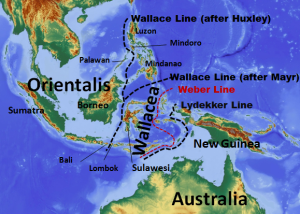
|
Researchers report* evidence of ancient human symbolic culture in the Wallacea zone of eastern Indonesia. Anatomically modern humans (AMHs) had colonized Wallacea by 47,000 years ago, but evidence of the cultural complexity associated with AMHs from the same period elsewhere in the world has been sparse. Adam Brumm and colleagues describe artifacts recovered from a cave on the Indonesian island of Sulawesi dated from 30,000-22,000 years ago. Some of the artifacts were bones and teeth of endemic animals modified into ornaments, including a bear cuscus bone likely to have been worn as a pendant and previously undocumented disc-shaped beads manufactured from the teeth of babirusas, also known as “pig-deer.” Several stone flakes were incised with various geometric patterns, possibly representing a form of portable art. The authors also found evidence for the use of pigment, such as ochre pieces with traces from scraping and grinding, ochre residues on stone artifacts, and a hollow long bone with traces of red and black pigment that may have been used as a kind of airbrush for creating rock art. According to the authors, the artifacts suggest the existence of a distinct symbolic culture in Wallacea that incorporated animals unique to the region. __________________________________ Map showing Wallacea. Altaileopard, Wikimedia Commons _____________________________________________ Article Source: PNAS news release. ______________________________________________ *“Early human symbolic behavior in the Late Pleistocene of Wallacea,” by Adam Brumm et al. _____________________________________________ |
Subscribe to Popular Archaeology Premium. Available on all laptops and mobile devices, and still the industry’s best value at only $9.00 annually.
___________________________________________
Travel and learn with Far Horizons.
____________________________________________
This richly illustrated issue includes the following stories: Recent findings shedding new light on the whereabouts of the remains of Philip of Macedon, father of Alexander the Great; how an archaeologist-sculptor is bringing bones of the dead back to life; archaeologists uncovering town life at the dawn of civilization; an exclusive interview with internationally acclaimed archaeologist James M. Adovasio about what makes the Meadowcroft Rockshelter prominent in the ongoing search for the first Americans; what archaeologists are finding at the site of the ancient city of Gath, the home town of the biblical Philistine giant, Goliath; and how scientists are redrawing the picture of human evolution in Europe. Find it on Amazon.com.








